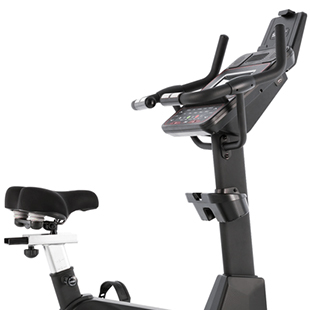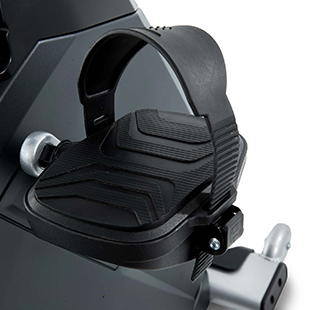BUYING AN EXERCISE BIKE
Exercise bikes are considered the most cost-effective cardio product and the easiest to use. However, there are also many factors to consider before deciding which is right for you.
This guide is designed to help you better understand the various components that make up an exercise bike and how to compare the quality of different machines. As with all equipment of this kind, the more the product costs, the higher quality it will inevitably be. So, it's important to know your usage requirements and matching these with the right machine. This can save you from future headaches in the form of possible breakdowns and repairs.
BIKE STYLE
The first thing to consider is that exercise bikes come in two main styles. There's the traditional upright style and the recumbent style. Upright bikes replicate the cycling action of a normal bicycle. Recumbent bikes place the body in a semi reclining position which offers extra lower back support. Recumbent bikes are recommended for older users or users with knee or hip problems. If you have any medical issues consult with your doctor or medical advisor prior to starting any new exercise routine.
BIKE FRAME

Consider the size, strength and stiffness of the construction when looking at the frame of an exercise bike.
There is only one sure way to check if the size of a bike is suitable for you personally; that is to get on the product and try it. Failing that, be sure to ask if the model you are looking at is suitable for your height and weight. We all have different physical dimensions so it's important that the bike fits you. Most modern exercise bikes will have adjustable handlebars, seat height and range to suit most users. Therefore as a very general rule, the bigger the bike frame the better, provided there is sufficient adjustment to fit smaller users.
Frame strength both in the steel tube and the welded joints is very important. When a bike is being used there are many stress points which carry quite high loads. Remember this machine is supporting your full body weight so you do not want anything breaking!
Frame stiffness is also important; if the frame is flexing when you're using the bike, it will wear out quickly. In addition, annoying squeaking or scraping noises will appear. Test the stiffness of a frame by sitting on the saddle with your feet on the pedals and gently pull and push on the handle bars. There should be very little or no flex movement during this test.
SADDLE OR SEAT
The different styles of bikes will have different seats. An upright bike will have a seat similar to a normal bicycle but bigger and softer. Comfort is the key here so look for a seat that includes air or gel cushioning.
Spin bikes are designed to replicate the style of a racing road bike therefore the saddles are smaller and more streamlined. Cushioning is not as important on these bikes as the user will have their weight further forward over the handlebars.
Recumbent bikes have much larger seats with back supports therefore comfort, support and adjustability are the most important considerations to look for here.
FLYWHEEL AND DRIVE SYSTEM
Most exercise bikes have plastic shrouds that cover the drive mechanism of the bike. The covers are designed for safety to keep objects such as fingers and toes out of the moving parts; this makes it a little more difficult to see the quality of the components. If there is any doubt, it is worth removing the cover to check these parts.
Bikes usually have a belt system which runs from the pedal crank to the flywheel. The flywheel is the heavy wheel which provides the resistance similar to riding a normal bicycle. As a general rule, the heavier the flywheel the better, as this provides smoother momentum when it is spinning.
An important area to check in this part of the bike is the quality of the bearings and crank as the flywheel runs on these. They are the areas of greatest wear. The easiest way to check these bearings is to try turning the crank with your hand on minimum load, feel how smooth it runs and listening for any scraping or grinding noise. This will give an indication as to the quality of the bearings and drive system.

PEDALS AND CRANKS
When considering the pedals, look for good sized pedals that provide solid foot support and adjustable straps that lock your foot in place. Some spin bike models will have the capacity for cycling cleats to be worn that clip into the pedal.
Also consider that this area of the bike takes a lot of wear, tear and strain. Many high-end models have what is known as a 3-piece crank which means the pedals are separate components fixed to a central axle. This assembly is stronger and is more practical to service and repair later on. Low cost bikes have a 1-piece crank that is more susceptible to flexing and breaking after prolonged use.
RESISTANCE
In order to replicate the feeling of riding up and down hills, exercise bikes have different resistance options built in. Most spin bike models use direct resistance which is a brake pad pressed directly onto the flywheel making the pedal crank harder to turn. The size and composition of the pad determines how smooth the resistance is.
Manual magnetic systems use opposing magnets which are positioned on either side of the flywheel. When a manual resistance control knob is turned by the user, magnets are pulled closer to the flywheel increasing the resistance.
Electromagnetic systems use electromagnetic brakes to control how freely the flywheel can spin. These are usually controlled by a push button on the control panel of the bike. Electromagnetic braking systems are the most accurate and sophisticated but are also the most expensive.
CONSOLE CONTROLS AND DISPLAYS
The control panel will have some form of LCD or LED display. They are available in various colours, shapes and sizes; much of the choice comes down to your personal preference and what type of information you wish to see.
The display can show such information as speed, distance, time, laps, incline, calories burned and heart rate. They aid in your experience but more programmes and gadgets don't necessarily mean a better quality product.
AFTER-SALES SERVICE
Finally, the most important consideration when purchasing an exercise bike is the company that supplies you the product. Do they offer after-sales services and back-up spare parts?
Exercise bikes are an investment, so be sure you are dealing with an established supplier that has a good history in the industry. Ensure they carry adequate stocks of spare parts and employ trained service technicians. This is especially important if you are purchasing online.
Check the warranties and make sure the supplier has the ability to back them up. Warranty promises are only as good as the company making them!
If you want to find the right exercise bike for you, check out our product selector: Which Exercise Bike is Right for You? and View our Exercise Bike Range
